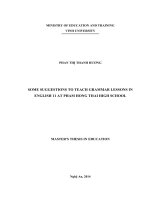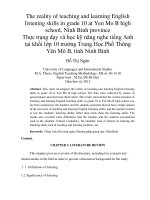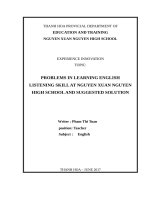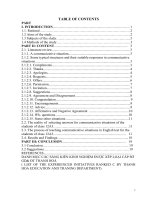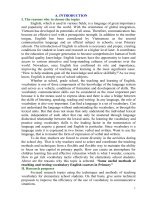Applying some new methods in teaching speaking skill in english 10 at tho xuan IV high school 1
Bạn đang xem bản rút gọn của tài liệu. Xem và tải ngay bản đầy đủ của tài liệu tại đây (493.03 KB, 20 trang )
SỞ GIÁO DỤC VÀ ĐÀO TẠO THANH HÓA
TRƯỜNG THPT4 THỌ XUÂN
SÁNG KIẾN KINH NGHIỆM
APPLYING SOME NEW METHODS IN TEACHING SPEAKING
SKILL IN ENGLISH 10 AT THO XUAN IV HIGH SCHOOL
Người thực hiện: Nguyễn Trọng Thắng
Chức vụ: Giáo viên
Đơn vị công tác: Trường THPT4 Thọ Xuân
SKKN thuộc môn: Tiếng Anh
THANH HÓA NĂM 2018
TABLES OF CONTENTS
1
1.Introduction
Reasons for choosing the study……………………………………..
Aims of the stduy…………………………………………………..
Subjects of the study……………………………………………….
Methods of the study………………………………………………
2. Contents of the study……………………………………….
2.1. Theoretical background………………………………………
2.2. Current status of the problem before applying the study………
2.2.1. Prepare……………………………………………………….
2.2.2. Reorganize the class………………………………………….
2.3. Some measures of organization………………………………
2.3.1. Preparing and arranging the speaking topics……………….
2.3.2. Forms and ways of organization……………………………
2.3.3. Prepare a source of knowledge for students to make speaking
and reflecting on situations…………………………………………
2.3.4. How to stimulate students to practise speaking skills from
the beginning of class until the end of class………………………..
2.3.5. Specific methods for teaching speaking parts.
2.3.6. Applying the method in teaching
2.4. Effectiveness of the study for educational activities, with
myself, the colleagues and the school………………………………
3. Conclusions and recommendations…………………………
3.1. Conclusions……………………………………………………
3.2. Recommendations…………………………………………….
Reference books……………………………………………………
Page
2
2
2
2
3
3
3
4
4
4
4
5
7
7
7
8
16
17
17
17
18
2
1. INTRODUCTION
Reasons for choosing the study:
In recent years the Ministry of Education and Training gave us 7 yeartextbooks on English subjects performed synchronously at secondary schools all
over the country, to meet the needs of today's new realities. Each unit of study was
compiled under five basic parts: Part A: Reading; Part B: Speaking; Part C:
Listening; Part D: Writing; Section E: Language focus.
Through the teaching process, we may find out that in the practice sessions
of design skills training activities are relatively reasonable, clearly help both
teachers and students can easily grasp its mission through each specific task in the
textbook.
However, over the years of teaching, I found that teaching speaking part at
high school has encountered many difficulties and obstacles. Students participating
in this class is not natural, and passive. This makes lessons become tedious, no
depth. Usually these classes are taught in a perfunctory, students do not
communicate effectively. Thus, the practice of language in communication in a
large part of students is not much.
2017-2018 school year, I myself have tried to learn, to explore ways to more
effectively to teach speaking skill. How to create training activities share
knowledge speaking skills classes become simple, practical, easy to remember high
communicative is what I always concern and think. Therefore, initiatives in this
study I want to share with colleagues:
"Applying some new methods in teaching speaking skill in English 10 at
Tho Xuan IV high school".
Aims of the study
This topic was conducted to help students improve speaking ability and
confidence to help them communicate, as well as help them to have more interest in
the English subject.
Subjects of the study
This study will investigate the student's interest in learning English. Then set
out a number of activities to renew methods in teaching speaking skill in English
10 at Tho Xuan IV high school
Methods of the study
Methods to build the theoretical basis: Learn the reality of the problem then
find out the solutions to solve the problem.
Methods actual survey, gathering information: Distributing questionnaires
learning attitude of students towards subjects in English before performing the
subject. Then gather information to grasp the spirit of their learning
3
Statistical methods, data processing: After applying the theme will be the
result statistics about the level of student progress to evaluate the success of your
project.
2. CONTENTS OF THE STUDY
2.1. Theoretical back ground
Vietnam, we are on the path of development and international
integration. Do That, English is a powerful decision-making tool. It is also possible
that English is considered a high school subject. Teaching and Learning English
There are many different and different ways to work, but it includes live action
files, academic calculations to help solve problems.
However, the ability to hear, speak, read and write, especially the speaking skills of
students, is the most difficult when communicating with foreigners. Because
communication is a good condition to stimulate learners to use foreign languages
effectively. However, this speaking skill is sometimes forgotten because we only
assess language through knowledge, not knowledge, measured by the ability to use
the language. So we have to pay a great deal of attention to this skill to equip
students with the ability to communicate confidently and fluently. In order to do
this, the instructor needs to organize a compelling learning environment to engage
more students. There are so new students confident enough, more courageous to
communicate a certain language later.
2.2. Current status of the problem before applying the study
Through the lessons, I found that most of the students are passive, not really
interested in learning. This is because the majority of students lack vocabulary, lack
of confidence, and the subject matter in textbooks is dry and unsuitable for
students.
When the teacher asks the children to work in groups, they just sit and stand up to
talk and push you to the best of the group. Therefore, they do not develop the
capacity of students nor create confidence in speaking English to them. And very
few students are interested in learning to speak.
Specifically, at the beginning of the school year, I distributed a questionnaire about
the joy when learning the speaking skills of the students in the 2 classes I taught as
10A1 and 10A2 as follows:
Like very much
Like
Dislike
And this is the result:
Class
Number
Like very much
Like
Dislike
4
10A1
10A2
45
46
5 (11,1%)
7 (15,2%)
10 (22,2%)
12 (26,1%)
30 (66,7%)
27 (58,7%)
From this point of view, I think it is necessary to innovate the method of teaching
speaking skills with various activities in order to promote the speaking skills and
activities to a moderate level, not too difficult nor too easy. .
However, through the speaking skills classes we can also promote the organization
of activities for students to work in groups, pairs, or individuals ..... These activities
encourage the I'm more confident, more self-confident and more active while
learning.
To do this is a great effort of teachers and pupils.
2.2.1. Prepare
Every plan we put out has to have goals and plans as clear and detailed as
we can achieve. So therefore:
- We have to know how to prepare and arrange the topic to suit the capacity and
level of the students.
- Organized classes in teams, groups.
Knowledge must be prepared so that students can speak and reflect in
situations.
- How to stimulate students to perform speaking practice from the beginning of
class until the end of class.
+ Students must prepare well vocabulary at home before class.
2.2.2. Reorganize the class
- Classroom teachers work in pairs, groups, teams to suit each activity.
- Bonus points if individuals, pairs or groups do well to encourage them, creating
excitement while learning.
2.3. Some measures of organization
2.3.1. Preparing and arranging the speaking topics : Do not stick to the
same activities as textbook topics because they will make students rigid and dry,
unable to fully explore and count. Creativity in student communication. Because of
the easy situation they do not speak, how to say difficult situations. Therefore we
should guide the students to follow the topics in the textbook then do it themselves
or in the same group to carry out the topics on the dialogue, self-comment ... in
accordance with their ability, then Repeat at class (maybe each child, each group
doing many different things).
By doing this, I realized that they were thinking, exploring and saying everything
they need to say. They are also very excited in the syllabus, expecting to have a
5
new subject sooner and more talkative because they have the opportunity to express
themselves and to express themselves.
This not only creates conditions for good students to express themselves but also
helps all students in the classroom, especially weak, timid, less English-speaking
students. Because they are better advised by students, prepared at home and
practicing well, they are not confident, confident in speaking and communicating in
public. Conditional to express.
2.3.2. Forms and ways of organization.
This is also the key skill that determines success or failure in
communication. If the class is not active, few students practice speaking skills, it is
unsuccessful. If the classroom is rattled, vibrant, uninhibited and many students
practice speaking skills then the class is considered successful.
Therefore, I think we should organize the "Open Classroom" - which can remove
students from their familiar position to find the right person or can stand in place to
do the speaking in pairs. Or group is very good (should not sit). By that time, the
students will be very comfortable to perform the activity as well as easy "hand
dance, dizziness" express the meaning of each sentence to the listener.
In the meantime, if you are afraid of the noise of the classroom and let your
students sit at their familiar places, they will be very passive and psychologically
inhibited. Therefore students can not promote the "vocabulary" they have, by
gesture, eye contact, action is also "magnetic" in the communication of each
language that makes the listener can understand. Moreover, if they are only told to
sit next to them, they will be very boring and not know all the characteristics of
each classmate.
If so then the class will be very noisy hard to manage and control?
This is a question many teachers are concerned about especially young
teachers. However, I also boldly say that learning to speak is not afraid of noise in
the classroom because of the "noisy in control" will make the classroom become
more exciting. Since after we finished asking the students to return to their seats or
sit down, they followed the "inertia" order. Then we can evaluate the comments and
suggestions for the speaking activities we have set out.
Therefore, during the speaking process, we recommend that students:
- Always speak slowly
Because most students believe that speaking English faster will be more
like native speakers because most English learners find it difficult to grasp
information when the native speakers speak because they speak quite fast.
However, the "say as fast as possible" view is completely wrong. Encourage them
to try to speak slowly and accurately. If the students slow down, their tone and
accent will become lighter, whereas their vocal tone will be heavier and more
difficult to understand, which is understandable because they will not. There is
6
enough time to form the correct phoneme and intonation. Take control of the
speaking speed as appropriate as the basic principle to achieve what you want.
- Speak loudly enough
This is an important factor in communication. Because whether you talk to
a person, 10 people or a hundred, you need to talk loud enough so all of the people
who are present can listen to you easily. If you talk too small, what will happen?
Practice speaking with a suitable volume will give you more confidence and can
adjust your volume to suit different spaces and circumstances. It is best to spend 15
to 20 minutes each day practicing English pronunciation by reading aloud words,
sentences, paragraphs in English. If students practice regularly every day for 3
months, then your muscles develop appropriately for speaking a new language. It is
possible to record your voice and hear the words you pronounce wrong. People
often hate to hear their own voice and tend to avoid hearing their voices. However,
this is a pretty important practice because in this way you can recognize the
mistakes that you often get.
- Pronounce all the sounds in words.
As mentioned above, slow English speaking practice will give you time to
focus on the sounds that are in the word. Maybe now, you can miss the last or the
middle of a word, or the syllables are not stressed in words. This does not affect the
speaker but makes it difficult for the listener. Therefore, it is recommended that
students focus on each syllable in the word and not miss any sounds, especially the
last syllables of the word such as "s", "ed", "t", "p", etc.
It is recommended to use a simple grammatical structure:
By the way, no one will notice that you use simple or complex structure to assess
your ability and even no one recognizes the level of structures you are using. So
use simple structure and sentence patterns to facilitate communication.
- Thoughts in English, should not be translated from Vietnamese.
One of the most serious mistakes is that we tend to "translate" (from
mother tongue into English) before speaking. This will immediately create a
language barrier. For example, when we want to give up an appointment, we will
think in mind: "I want to cancel the appointment." Then we translate that sentence
into English. We will have problems because we may not remember or know the
words "cancel" and "appointment" to form the sentence "I would like to cancel the
appointment". If we think in English, we will not have this problem and there are
many ways of expressing this situation in English, for example: "I'm sorry. I'm not
free tomorrow "or" I'm afraid I can not come tomorrow ", etc.
- Do not be self-deprecated about your English ability. For example: When you
are asked "How is your English?", You should not answer: "Oh, my English is very
poor, I should not answer to practice", you should reply: "I love to speak English"
7
Or "My English is improving". Answers like this will give you a sense of
confidence. When you are confident, you will no longer be afraid to speak English.
2.3.3. Prepare a source of knowledge for students to make speaking
and reflecting on situations in situations: There are many sources of knowledge
that students can collect, but the problem is that they work and accumulate brain? If
we do not guide them, then maybe they will say without purpose. So first and
foremost, we should make simple sentences, conversations, and simple sentences
for students to easily use and excite in speaking. Then rely on the sentence patterns,
that dialogue to impose on the subject in the textbook to help students surprise.
So we have to know how to process the knowledge to suit the taste of
students. We have to thicken the collection of images and materials related to the
topic or new words in the lesson: These pictures we can zoom into a large image or
shrink many different shapes to insert a Small paper to give students practice. In
this way we do not need to spend a lot of time explaining new words that are of
interest to our students. Because when students look at the pictures, students will
not care about new words anymore. In the beginning always think of how to
express the pictures properly. Since then the psychology of students will not be
heavy on vocabulary, so it will stimulate the speaking skills more.
2.3.4. How to stimulate students to practice speaking skills from the
beginning of class until the end of class? If you are not well prepared for the
lessons, the lessons are often very sporadic and tiring for the learner as well as the
instructor. Teachers should be prepared logically from the beginning to the end of
the session and should not be left with too much "downtime". Because that will
distract the student, feel depressed and not excited for speaking.
2.3.5. Specific methods for teaching speaking parts:
+. Before speaking ). We can use:
- Matching
- Pre-teach vocabulary
- Open prediction
- Ordering
- Answer the guiding questions (pre- question )
- Games
+. While speaking). We can use:
- Giving opinions
- Discussing
- Ask and answer
- Matching
+. After speaking): We can use:
- Interviewing
- Recall/ retell the story or dialoguge.
8
- Role play/ taking a survey
- Discuss the main idea.
- Summerising the main points
- Card Deck
2.3.6. Applying the method in teaching
UNIT 8: THE STORY OF MY VILLAGE
Lesson 2: Speaking
I. Objectives: By the end of the lesson, students will be able to talk about plans
and their possible results.
IV. Anticipated problems:
- There are some new words.
- Students usually know one way to raise plans Teacher can ask them to use
different ways to talk.
III. Teaching aids: Pictures, textbook, tapes, projector.
IV. Procedure:
Teacher’s activities
* Warm-up: (3 minutes)
Fill in each gap with one missing letter to make
meaningful words
1. RO-D
2. BRI-G3. SCH- -L
4. FO-TB-LL GR-UND
5. M-DIC-L C-NT-E
- Asks the fastest one to write the answers on board.
- Give the keys.
1. ROAD
2. BRIDGE
3. SCHOOL
4. FOOTBALL GROUND
5. MEDICAL CENTRE
I. Pre-speaking: ( 3 minutes)
- Shows a picture of Ha Xuyen village.
Students’ activities
- Students do in groups of
three or fours.
- Others look at the screen
and correct
9
- Discuss in pairs
- Take turns to talk about
Ha Xuyen village.
- Asks students to look at the pictures and suggestion
to talk about Ha Xuyen village.
1. The road is narrow.
2. The school is small and
poor.
3. There is no bridge in Ha
Xuyen village.
4. There is no medical
centre in Ha Xuyen
village.
5. There is no football
ground in Ha Xuyen
village.
Road/ narrow
School/ small and poor
+ There/ no bridge/ in Ha Xuyen village.
+ There/ no medical centre/ in Ha Xuyen village.
+ There/ no football ground/ in Ha Xuyen village.
- Raises the question:
What should we do to improve the life in the village?
- Leads in new lesson: Let’s practice talking about the
plans to improve the life in Ha Xuyen village and their
10
possible results.
II. While-speaking: (30 minutes)
Task 1: (5 minutes) The villagers of Ha Xuyen are
discussing plans to improve the life in the village.
Look at the pictures and say what they should do.
- Ask sts to practise in pairs before presenting in front
of the class.
- Practise speaking in pairs
- Take turns to talk .
Now
They should widen the
road.
In the future
Now
11
They should build a new
school.
In the future
Now
They should build a new
bridge.
In the future
12
In the future
They should build a
medical centre.
In the future
- Supposes students are Ha Xuyen villagers, give a
model:
A: What should we do to improve the life in the
village?
B: I think we should widen the road
- Gives more suggestion and asks students to produce
the similar conversations.
+ Widen the road
+ Build a new school
+ Build a bridge
+ Build a medical centre
+ Build a football ground
Task 2: ( 2 minutes)
Match each of the plans with its possible result
- Raise some plans and possible results:
They should build a
football ground
13
* Plans:
1. Resurface the road
2. Build a medical centre
3. Build a football ground
4. Grow cash crops
5. Build a bridge
6. Build a new school
* Possible results:
a. Children will have better learning conditions; they
will be more interested in learning.
b. Villagers will have a shorter way to town; cars and
lorries can get to the village.
c. People’s health will be looked after better; the sick
will be cured in time.
d. Young people can play sports; people can hold
festival there.
e. People can export the crops; they will have more
money.
f. Roads will not be muddy and flooded after it rains;
people can get around more easily
- Presents new words.
* Match each word with its Vietnamese equivalent
Words
Vietnamese
equivalents
1. Flooded
a. Trải lại (mặt đường)
2. Cure
b. Lầy lội
3. Export
c. Bị ngập lụt
4. Muddy
d. Xuất khẩu
5. Resurface
e. Chữa trị
- Asks one student to write the answers on board
- Give the keys.
* Keys: 1-c; 2-e; 3-d; 4-b; 5-a
- Read the model in
chorus.
- Practice in pairs
- Read the plans and
results to find out new
words.
- Asks students to match each of the plans with its
possible result
- Show the keys and correct the answers on board.
* Keys: 1-f; 2-c; 3-d; 4-e; 5-b; 6-a
Task 3: ( 2 minutes)
Produce conversations in groups of three
14
or four
- Gives model:
A: What should we do to improve the life in the
village?
B: I think we should resurface the roads
C: That’s a good idea. If we resurface the roads,
they won’t be muddy and flooded.
D: Yes. And people can get around more easily
- Lets students produce conversations in groups.
- Asks some groups to present in front of the class.
IV. Post-speaking: ( 7 minutes)
- Gives question relate to the fact
What should we do to improve our English?
- Work in pairs.
- Look at the screen to
correct
- Copy then read the new
words in chorus.
- Read the model in group
of four.
- Work in groups
Practice English everyday
- Look at the pitures and
suggestion to ask and
answer in pairs.
A: What should we do to
improve our English?
B: We should practice
English everyday.
15
Speak English to foreigners
A: What should we do to
improve our English?
B: We should speak to
foreigners.
Listen to English tapes
- Gives suggestions and asks students to complete the
conversation.
PLANS
RESULTS
- Practice English
- Get good marks
everyday
in English.
- Speak English to
- Speak English
foreigners
more fluently
- Listen to English
- Widen our
tapes
English
- Read many English
vocabularies.
books.
- Do English tests
better
* Complete this conversation:
A: We are not very good at English.
What should we do to ………………………….?
B: I think we should ………………………………..
C: Yes, if we …………………, we can …………….
D: That’s a good idea.
- Asks two or three pairs to present.
V. Homework: ( 2 minutes)
- Learn all new words by heart then make sentences
with them.
- Write four conversations in the notebook
- Prepare new word for listening lesson.
A: What should we do to
improve our English?
B: We should listen to
English tapes
- Work in pairs.
16
2.4. Effectiveness of the study for educational activities, with myself, the
colleagues and the school
- In the course of each lesson, each content is different, I do different ways
to organize lessons to not be boring and suitable with the ability of students
classroom class. The results of the students learning faster, more effective. They
were more comfortable discussing and practicing because I followed the process
from easy to hard. Since then they are interested in learning for students and they
are more and more interested in the subject.
- Students can speak simple sentences, practice simple social
conversations.
- As a facilitator, teachers are also more easy.
Specifically after one year I taught in 2 classes 10A1 and 10A2, I gave a
replay of the excitement during the semester at the end of the school year and gave
the following results:
Class Number
Like very much
Like
Dislike
10A1
45
20 (44,4%)
15(33,3%)
10 (22,3%)
10A2
46
19 (41,3%)
17 (37%)
10 (21,7%)
Compared with the result at the beginning of the year:
Class Number
Like very much
Like
Dislike
10A1
45
5 (11,1%)
10 (22,2%)
30 (66,7%)
10A2
46
7 (15,2%)
12 (26,1%)
27 (58,7%)
As a result, the results of the re-search have shown very positive results
and reflected the effectiveness of this method and it contributes to the results of
English subjects are more advanced.
3. CONCLUSIONS AND RECOMMENDATIONS
3.1. Conclusions
Teaching English at high schools, especially those located in areas where the
economy is difficulty is a hard work, however, that is not an impossible mission. To
solve these problems, the first thing that requires teachers to have the mind to the
job, hard to explore teaching methods to suit each student audience, gradually
resolve the difficulties, discipline problems of a most efficient way.
3.2. Recommendations
Through this study, I want to contribute a small part in helping students
practice speaking skills through specific training activities most effectively, and
also the desire to share a bit of teaching experience I taught in English with all
17
colleagues. I really hope that it will be a useful resource for the teaching of
speaking parts most efficiently
XÁC NHẬN CỦA THỦ TRƯỞNG Thanh Hóa, ngày 20 tháng 5 năm 2018
ĐƠN VỊ
Tôi xin cam đoan đây là SKKN của
mình viết, không sao chép nội dung
của người khác.
(Ký và ghi rõ họ tên)
Nguyễn Trọng Thắng
REFERENCE BOOKS
18
1. English 10 (Hoàng Văn Vân, Hoàng Thi Xuân Hoa, Đỗ Tuấn Minh, Nguyễn
Thu Phương, Nguyễn Quốc Tuấn)-Nhà xuất bản giáo dục.
2. English 10-Teacher book (Hoàng Văn Vân, Hoàng Thi Xuân Hoa, Đỗ Tuấn
Minh, Nguyễn Thu Phương, Nguyễn Quốc Tuấn)-Nhà xuất bản giáo dục.
3. Thiết kế bài giảng Tiếng Anh 10 (Chu Quang Bình) –Nhà xuất bản Hà Nội
4. Giới thiệu Giáo Án Tiếng Anh 10 (Vũ Thị Lợi, Đồng Thị Yến Trang, Nguyễn
Thị Ý, Võ Thị Minh Hồng, Tôn Nữ Hạnh Trâm, Nguyễn Thị Kim Dung)Nhà xuất bản Hà Nội.
5. Hướng dẫn thực hiện chuẩn kiến thức, kĩ năng môn Tiếng Anh THPT –Nhà
xuất bản Giáo Dục Việt Nam
DANH MỤC
19
CÁC ĐỀ TÀI SÁNG KIẾN KINH NGHIỆM ĐÃ ĐƯỢC HỘI ĐỒNG ĐÁNH
GIÁ XẾP LOẠI CẤP PHÒNG GD&ĐT, CẤP SỞ GD&ĐT VÀ CÁC CẤP
CAO HƠN XẾP LOẠI TỪ C TRỞ LÊN
Họ và tên tác giả: Nguyễn Trọng Thắng.
Chức vụ và đơn vị công tác: Trường THPT4 Thọ Xuân
TT
1.
Tên đề tài SKKN
Vận dụng phương pháp dạy
học hợp tác theo nhóm nhỏ ở
Kết quả
Cấp đánh
đánh giá
Năm học
giá xếp loại
xếp loại đánh giá xếp
(Phòng, Sở,
(A, B,
loại
Tỉnh...)
hoặc C)
Sở giáo dục C
Năm 2011
và đào tạo
Thanh Hóa
trên lớp trong dạy học tiếng
2.
Anh lớp 10- Hệ 7 năm
Thiết kế lại các hoạt động
trong phần “ Post-listening”-
3.
Tiếng Anh lớp 10 (Cơ bản)
Some activities help students
practise speaking skill
Sở giáo dục
và đào tạo
Thanh Hóa
C
Năm 2012
Sở giáo dục
và đào tạo
Thanh Hóa
C
Năm 2016
Sở giáo dục
và đào tạo
Thanh Hóa
C
Năm 2017
effectively in English 12
4.
(Basic)
Renewing methods in
teaching speaking skill in
English 10,11,12 at Tho Xuan
IV high school
----------------------------------------------------
20


